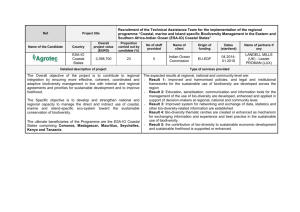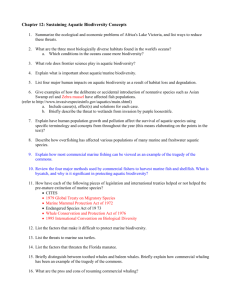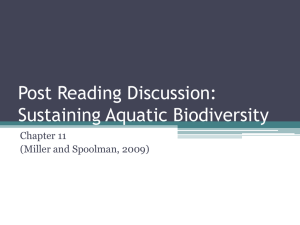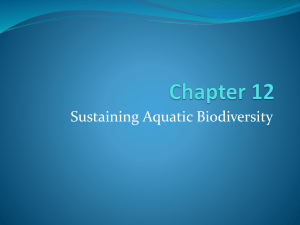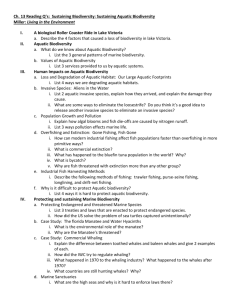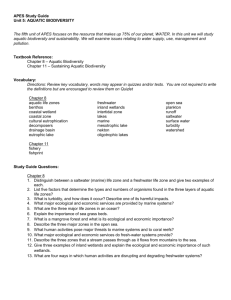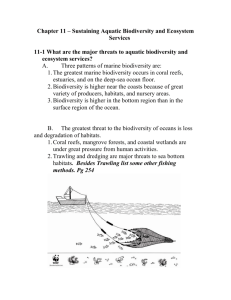Chapter 11 Sustaining Aquatic Biodiversity Summary Key Questions
advertisement
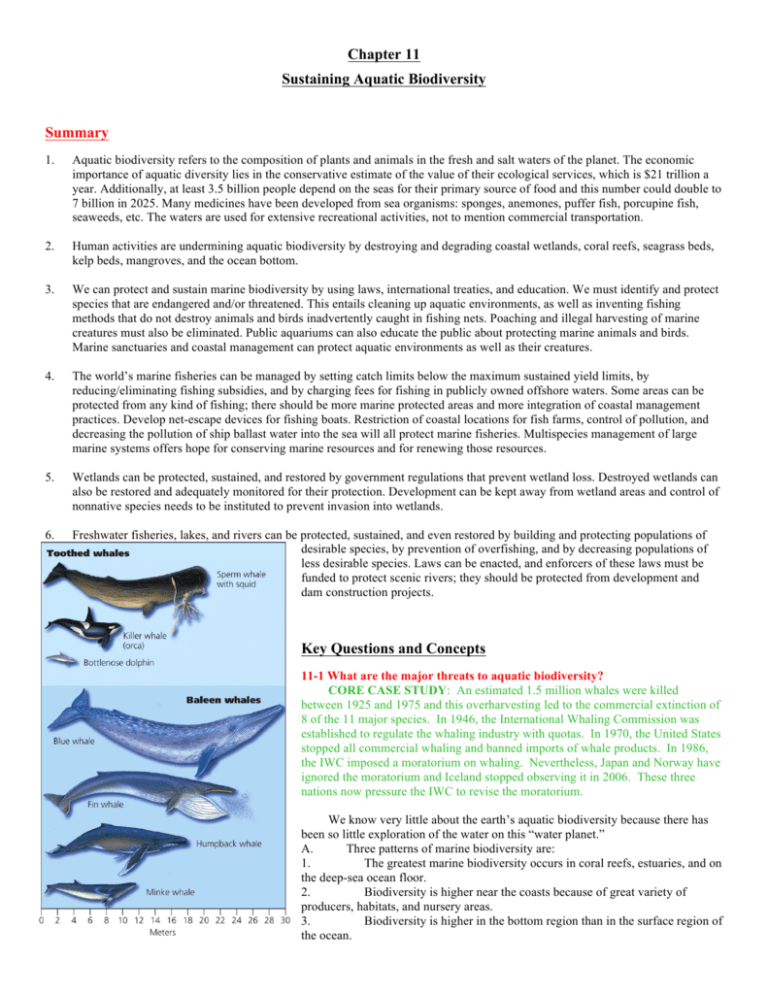
Chapter 11 Sustaining Aquatic Biodiversity Summary 1. Aquatic biodiversity refers to the composition of plants and animals in the fresh and salt waters of the planet. The economic importance of aquatic diversity lies in the conservative estimate of the value of their ecological services, which is $21 trillion a year. Additionally, at least 3.5 billion people depend on the seas for their primary source of food and this number could double to 7 billion in 2025. Many medicines have been developed from sea organisms: sponges, anemones, puffer fish, porcupine fish, seaweeds, etc. The waters are used for extensive recreational activities, not to mention commercial transportation. 2. Human activities are undermining aquatic biodiversity by destroying and degrading coastal wetlands, coral reefs, seagrass beds, kelp beds, mangroves, and the ocean bottom. 3. We can protect and sustain marine biodiversity by using laws, international treaties, and education. We must identify and protect species that are endangered and/or threatened. This entails cleaning up aquatic environments, as well as inventing fishing methods that do not destroy animals and birds inadvertently caught in fishing nets. Poaching and illegal harvesting of marine creatures must also be eliminated. Public aquariums can also educate the public about protecting marine animals and birds. Marine sanctuaries and coastal management can protect aquatic environments as well as their creatures. 4. The world’s marine fisheries can be managed by setting catch limits below the maximum sustained yield limits, by reducing/eliminating fishing subsidies, and by charging fees for fishing in publicly owned offshore waters. Some areas can be protected from any kind of fishing; there should be more marine protected areas and more integration of coastal management practices. Develop net-escape devices for fishing boats. Restriction of coastal locations for fish farms, control of pollution, and decreasing the pollution of ship ballast water into the sea will all protect marine fisheries. Multispecies management of large marine systems offers hope for conserving marine resources and for renewing those resources. 5. Wetlands can be protected, sustained, and restored by government regulations that prevent wetland loss. Destroyed wetlands can also be restored and adequately monitored for their protection. Development can be kept away from wetland areas and control of nonnative species needs to be instituted to prevent invasion into wetlands. 6. Freshwater fisheries, lakes, and rivers can be protected, sustained, and even restored by building and protecting populations of desirable species, by prevention of overfishing, and by decreasing populations of less desirable species. Laws can be enacted, and enforcers of these laws must be funded to protect scenic rivers; they should be protected from development and dam construction projects. Key Questions and Concepts 11-1 What are the major threats to aquatic biodiversity? CORE CASE STUDY: An estimated 1.5 million whales were killed between 1925 and 1975 and this overharvesting led to the commercial extinction of 8 of the 11 major species. In 1946, the International Whaling Commission was established to regulate the whaling industry with quotas. In 1970, the United States stopped all commercial whaling and banned imports of whale products. In 1986, the IWC imposed a moratorium on whaling. Nevertheless, Japan and Norway have ignored the moratorium and Iceland stopped observing it in 2006. These three nations now pressure the IWC to revise the moratorium. We know very little about the earth’s aquatic biodiversity because there has been so little exploration of the water on this “water planet.” A. Three patterns of marine biodiversity are: 1. The greatest marine biodiversity occurs in coral reefs, estuaries, and on the deep-sea ocean floor. 2. Biodiversity is higher near the coasts because of great variety of producers, habitats, and nursery areas. 3. Biodiversity is higher in the bottom region than in the surface region of the ocean. B. The greatest threat to the biodiversity of oceans is loss and degradation of habitats. 1. Coral reefs, mangrove forests, and coastal wetlands are under great pressure from human activities. 2. Trawling and dredging are major threats to sea bottom habitats. 3. Dams and excessive water withdrawal are destroying freshwater habitats. Figure 11.2: Natural capital degradation. These photos show an area of ocean bottom before (left) and after (right) a trawler net scraped it like a gigantic bulldozer. These ocean-floor communities could take decades or centuries to recover. According to marine scientist Elliot Norse, “Bottom trawling is probably the largest human-caused disturbance to the biosphere.” Trawler fishers disagree and claim that ocean bottom life recovers after trawling. C. Harmful invasive species increasingly threaten marine biodiversity. 1. Blamed for 2/3 of fish extinctions in the United States, and may cost the nation about $16 million/hour. Figure 11.3: One scientist has described this common lionfish as “an almost perfectly designed invasive species.” It reaches sexual maturity rapidly, has large numbers of offspring, and is protected by venomous spines. In the eastern coastal waters of North America, it has few if any predators, except perhaps for people. It is hoped that commercial fishers can find ways to capture lionfish economically and that consumers will choose them from seafood menus. SCIENCE FOCUS: One obstacle to protecting ocean biodiversity is lack of information. Researchers hope to gather more data by deploying a series of small robotic devices that can take measurements and send the information back to the lab. CASE STUDY: Lake Victoria was once known for its endemic cichlid fish diversity. Since 1980, 200 species of cichlids have gone extinct. One cause was the introduction of Nile perch. Another factor is algal blooms caused by nutrient rich runoff and sewage. SCIENCE FOCUS: Lake Wingra in Wisconsin receives excessive nutrients from runoff and is populated by invasive species, including carp and purple loosestrife. The carp devour the algae that would normally stabilize sediments on the lake bottom. Scientific experiments that involved excluding carp from a study area showed that algae recolonized and the lake water became noticeably clearer. There is now an effort to remove the carp from the rest of the lake to alleviate the effects of this invasive species. D. By 2020, 80% of the world’s population will live near coasts. Population growth and pollution have drastic effects on ocean systems. 1. Pollutants such as nitrogen from fertilizers can cause algal blooms and eutrophication. 2. Toxic pollutants can kill some aquatic life forms. 3. Plastic garbage in the oceans is having detrimental effects on wildlife. E. Climate change threatens aquatic biodiversity and ecosystems services. F. Overfishing can have drastic effects on biodiversity. 1. Global fishing is taking 57% more than sustainable yield. 2. Overfishing can lead to commercial extinction, which occurs when it is no longer profitable to continue fishing the affected species. 3. When populations of predatory species dwindle, invasives can take over. CASE STUDY: Industrial fishing dominates the global fishing industry. Trawler fishing extracts fish and shellfish from the ocean floor. Purse-seine fishing is used to catch surface dwelling species. Longlining strings out thousands of baited hooks as much as 80 miles long. Finally, drift netting involves massive nets that can lead to overfishing. In 1992, the UN limited the size of driftnets that could be used in international waters, but compliance is voluntary. SCIENCE FOCUS: Clashing scientific views on the state of global seafood stocks led two scientists to devise new methods for relating the catch of a given species to its estimated population. They formulated new targets based on population data and overall ecosystem health. They agreed that efforts to change correct fishing methods can be successful, and that at least 63% of global fish stocks are being overexploited. A. Many fish species are threatened with extinction. 1. 27% of marine species and 71% of freshwater species may face extinction within the next 60-70 years. 11-2 How can we protect and sustain marine biodiversity? A. Protecting marine biodiversity is challenging because it is difficult to monitor the impact of the human ecological footprint, oceans are unseen by most people, oceans are often thought to be inexhaustible resources, and most of the ocean area lies outside of the jurisdiction of any nation. 1. National and international laws and treaties include CITES, the 1979 Global Treaty on Migratory Species, the US Marine Mammal Protection Act, the Endangered Species Act, the US Whale Conservation and Protection Act, and the International Convention on Biological Diversity. CASE STUDY: The International Whaling Commission’s moratorium on whaling has been successful in helping some species to recover. As a result some nations are calling for the moratorium to be lifted. Still, many think it should remain in place to ensure a more complete recovery of whale populations. B. Biodiversity can be valuable to local communities that develop eco-tourism markets. CASE STUDY: Six of the seven species of marine turtles are endangered. Leatherback turtles are being heavily impacted by human activities. Fishing practices, pollution, and climate change all threaten their survival. However, there has been progress. Some local communities are reducing their impacts on beaches where turtles lay their eggs, Turtle Excluder Devices are now required on trawlers by the U.S. government, and some communities are focusing on the economic advantages of protecting these species C. A country’s offshore fishing zone extends 370 kilometers from its shores. 1. Ocean areas beyond these Exclusive Economic Zones, called the high seas, are difficult to monitor. 2. The World Conservation Union helped establish a global system of marine protected areas (MPAs). 3. There are about 4,000 MPAs; however, most MPAs allow ecologically harmful activities like trawling, dredging, and resource extraction. D. Scientists are advocating an ecosystems approach to sustaining marine biodiversity. 1. This would entail a network of protect marine reserves, closed to extractive activities. 2. Studies show that fish are larger, reproduce more often, and are present in greater variety. 3. Less that 1% of the world’s ocean area is closed to fishing in marine reserves. E. Reconciliation ecology can be directed at bringing back reefs, mangrove forests, coastal marshes and sea grass beds. F. Integrated coastal management is a community-based effort to develop and use coastal resources more sustainably. 1. The idea is to find cost-effective, adaptable solutions to preserve biodiversity while meeting economic and social needs. 11-3 How should we manage and sustain marine fisheries? A. One way to prevent overfishing is to develop better ways to protect fish populations. The maximum sustained yield mathematical model is used, but indications are that it has hastened the collapse of most commercially valuable stocks for several reasons. B. Optimum sustained yield is a concept that takes into account interactions with other species and allows more room for error. Another approach is multi-species management of a number of interaction species, which accounts for competition and predator-prey interactions. 1. There has been limited management of several large marine systems, such as the Mediterranean Sea. 2. Many fisheries scientists and environmentalists are interested in using the precautionary principle for management of fisheries and marine systems. C. Some fishing communities regulate fish harvests on their own and others work with the government to regulate them. Influx of large modern fishing boats and fleets has weakened the ability to regulate and sustain local fisheries. Many community management systems are now co-managed, where community and government work together to manage fisheries. 1. Central government sets quotas for various species and divides the quotas among communities. 2. Government may also limit fishing seasons and regulate gear to be used. 3. Each community then allocates its quota among members. D. Government subsidies that are intended to keep businesses afloat can encourage overfishing. E. Individual transfer rights (ITRs) are assigned to each fisherman, and these can then be bought, sold, or leased like private property. F. Individuals can help sustain aquatic diversity by demanding sustainably harvested seafood. 1. Labeling seafood would inform consumers. 11-4 How should we protect and sustain wetlands? A. Coastal and inland wetlands are important reservoirs of aquatic biodiversity; they provide ecological and economic services. 1. Despite their value, the U.S. has lost more than half of its coastal and inland wetlands since 1900. 2. Wetland loss in the U.S. will get worse as global warming leads to rising sea levels, which will put many coastal wetlands under water. B. In the U.S., a federal permit is required to fill or deposit dredge material into many wetlands. 1. The U.S. federal policy is a zero net loss goal; mitigation banking allows destruction of some wetlands as long as the same type of wetland is created elsewhere. CASE STUDY: An ambitious restoration project is trying to undo the human damage in South Florida’s Everglades. The natural Everglades is half its original size and is drying out, leaving it vulnerable to fire and invasion by nonnative species. Everglades National Park was set up in the lower part of the Everglades, but water didn’t flow into it and human activity caused disturbances. Ninety percent of the wading birds are gone and other vertebrates are reduced in number by 75–95%. Florida Bay has become saltier and warmer due to lack of water flow from the Everglades and the Kissimmee River. Loss of water flow and input from crop fields and cities has caused large algal blooms on the bay. These blooms threaten coral reefs and hinder diving, fishing, and the tourist industry of the bay and the Florida Keys. The U.S. Army Corp of Engineers has begun a restoration project funded by the state and the federal government to restore the meandering river and flow of water to the Everglades. It has several ambitious goals, which include restoring curving flow of more than half of the Kissimmee River, removing 250 miles of canals and levees south of Lake Okeechobee, buying 93 square miles of farmland and allowing it to flood to create artificial marshes, creating a network of artificial marshes, creating 18 large reservoirs to ensure water for south Florida’s present and future population and the lower Everglades, and building new canals, reservoirs, and pumping stations to capture and return to the Everglades 80% of the water flowing out to sea. 11-5 How can we protect and sustain freshwater lakes, rivers, and fisheries? A. There are many threats to freshwater ecosystems, including habitat destruction, invasive species, climate change and overharvesting fish. CASE STUDY: Invasions by nonnative species have upset the ecological functioning of the Great Lakes for decades, with more invaders coming. At least 162 nonnative species have invaded the Great Lakes since the 1920s. Measures have been taken to control a number of these species. Sea lampreys are one of the biggest threats and have depleted a number of the sport fish species in the lakes. Zebra mussels were brought into the lakes in ballast and have become very aggressive pests since they have no known natural enemies. They have displaced native mussel species, clogged pipes and piers, fouled beaches, and have spread to other parts of the U.S. Quagga mussels invaded the Great Lakes in 1991 and Asian Carp are now found within a few miles of Lake Michigan.. B. Rivers/streams are important ecological and economic resources, but they can be degraded by overfishing, pollution, dams, and water withdrawal. C. The Columbia River has been altered by 119 dams and withdrawal of water for agriculture. D. To protect rivers and lakes from excess pollutants, watersheds need to be protected. E. The National Wild and Scenic Rivers Act was passed in 1968 to protect rivers and river segments with outstanding scenic, recreational, geological, wildlife, historical, or cultural values. F. Congress established a three-tiered classification scheme: 1. Wild rivers are relatively inaccessible; they are not permitted to be widened, straightened, dredges, filled or dammed. 2. Scenic rivers are free from dams, mostly undeveloped, of great scenic value, and accessible in some places by roads. 3. Recreational rivers are readily accessible by roads and may have some dams or development along their shores. 4. In 2009, Congress increased the total length of wild and scenic rivers by half. Still, less than 1% of the country’s total river length is protected. G. Sustainable management of freshwater fish involves encouraging populations of commercial/sport fish species, prevents overfishing, and reduces or eliminated less desirable fish populations. 11-6 What should be our priorities for sustaining aquatic biodiversity? A. There is evidence that the harmful effects of human activities on biodiversity can be reversed over the next two decades. 1. This must entail an ecosystem approach to protecting biodiversity. 2. Priorities should be mapping aquatic biodiversity, identifying and preserving hotspots, creating fully protected marine reserves, protecting and restoring lakes and rivers, initiating ecological restoration projects worldwide, and finding ways to raise the incomes of people who live near protected waters. Key Terms fishery fishprint
